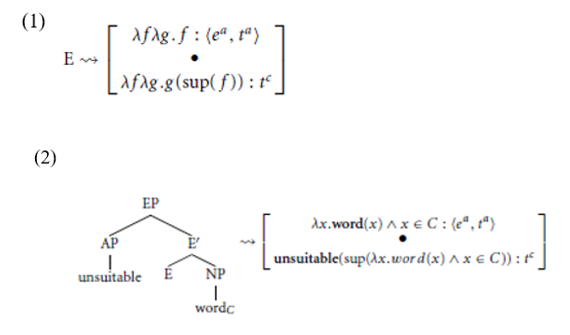


 Grammar
Grammar
 Tenses
Tenses
 Present
Present
 Past
Past
 Future
Future
 Parts Of Speech
Parts Of Speech
 Nouns
Nouns
 Verbs
Verbs
 Adverbs
Adverbs
 Adjectives
Adjectives
 Pronouns
Pronouns
 Pre Position
Pre Position
 Preposition by function
Preposition by function 
 Preposition by construction
Preposition by construction
 Conjunctions
Conjunctions
 Interjections
Interjections
 Grammar Rules
Grammar Rules
 Linguistics
Linguistics
 Semantics
Semantics
 Pragmatics
Pragmatics
 Reading Comprehension
Reading Comprehension|
Read More
Date: 2024-01-24
Date: 2024-01-06
Date: 2024-01-12
|
Some analytical possibilities- An alternative approach
Quite clearly, the proposal laid out here rests on a highly unorthodox and in some respects odd idea: that once fundamental distinctions are made among different tiers or layers of meaning, it makes sense to ask whether even the very basic notion that semantics is insensitive to linear order should necessarily carry over from standard descriptive meaning. But this must at this point be regarded as a kind of conjecture – alternative explanations of these facts are possible.
Chris Kennedy (p.c.) suggests one alternative route. Potts’ proposal, and consequently the proposal here that builds on it, would place the burden of relating expressive and at-issue meaning squarely on the shoulders of the semantics. Instead, one might place more of the explanatory burden on the syntax, thereby simplifying the semantics. Rather than a separate rule of Expressive Predicate Modification or CI Application, one might instead suppose there is a functional head E, that takes APs as specifiers and NPs as complements, or AdvPs as specifiers and VPs as complements. Semantically, it would do what Expressive Predicate Modification does:

This has several advantages. First, and most relevant here, it is more semantically conservative – it doesn’t commit to any notion that the semantics must be sensitive to linear order. Second, the place where linear order is expressed on this view is in the syntax of E, which seems natural. Third, this accounts for cross-linguistic variation in a fairly direct way. Languages that differ in the positions in which nonrestrictive modification is possible can be understood to differ either in the position in the sentence E occupies or in its headedness. And perhaps the greatest advantage of this approach is that it is consistent with a stronger notion of compositionality. Expressive Predicate Modification introduces elements of semantics – such as the supremum operator – that correspond to no linguistic expression and nothing in the syntax.
These are significant, of course. But of course, they don’t come for free. Most obviously, while this alternative approach is clearly more conservative in terms of the architecture of the grammar, it is certainly less syntactically conservative. Of course, if an overt expression of E could be discovered – or some other independent syntactic evidence could be brought to bear on the issue – this would be an appealing approach. And taking a syntactic leap in this way has the methodological advantage of compelling one to look for such evidence. Precisely because of that, though, it removes any pressure to look harder for evidence of semantic sensitivity to linear order, so this methodological argument could cut either way.
Another difficulty with this approach is that it embodies essentially the Cinquean conception that proved problematic, the nonrestrictive/restrictive contrast seems to cross-cut other semantically based adjective and adverb classes. Thus, even though this is essentially a Cinquean approach, in a curious way it would be difficult to reconcile with a broader Cinquean model – one would have to find principled answers to questions like: Should a nonrestrictive evaluative adjective occupy the specifier position associated with evaluative adjectives or expressive adjectives, or somehow both? This would be an odd state of affairs in another respect, too.
The principal motivation for the hypothesis that modifiers occupy specifier positions to functional heads is that this may provide a means of understanding otherwise mysterious restrictions on modifier order. But nonrestrictive modifiers don’t seem to be associated with a fixed position relative to other adjectives in quite the same way other adjectives are.
That said, at present there does not appear to be any data in this domain that could serve as a case against the alternative approach in (1) and (2).
|
|
|
|
التوتر والسرطان.. علماء يحذرون من "صلة خطيرة"
|
|
|
|
|
|
|
مرآة السيارة: مدى دقة عكسها للصورة الصحيحة
|
|
|
|
|
|
|
دراسة تستعرض آلام السجناء السياسيين في حقبة البعث المجرم في العراق
|
|
|